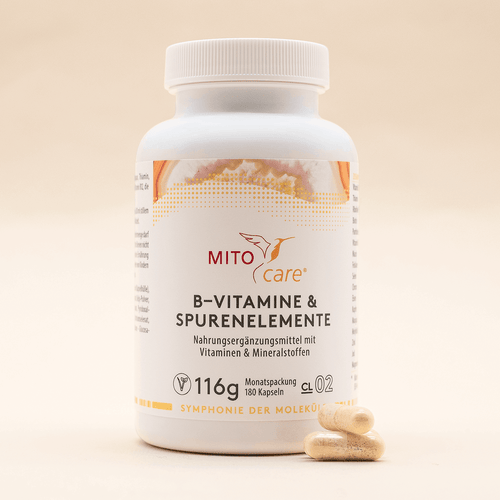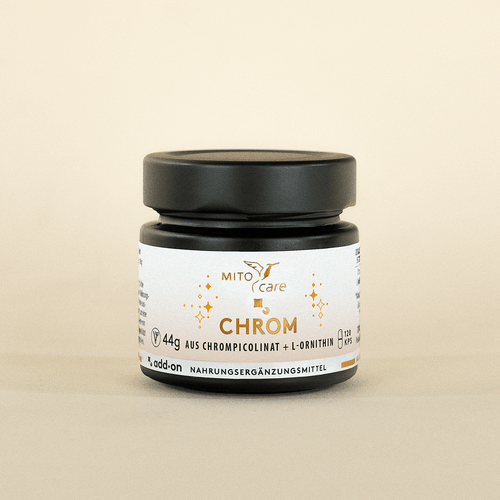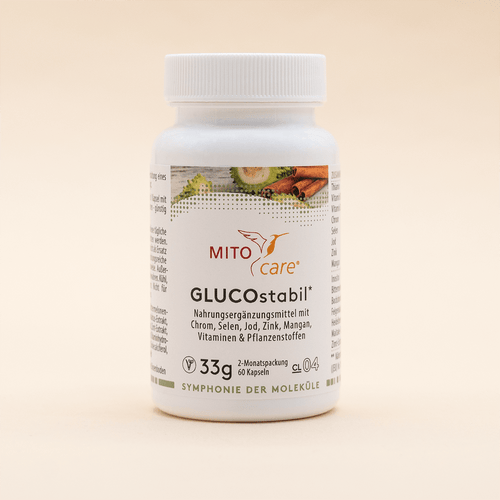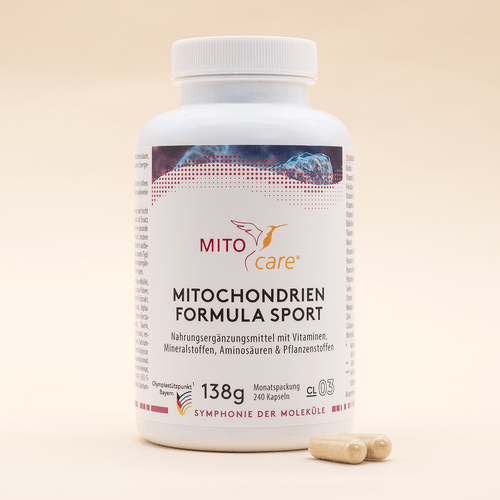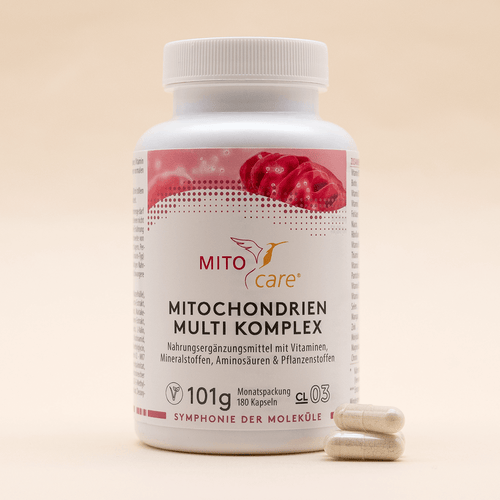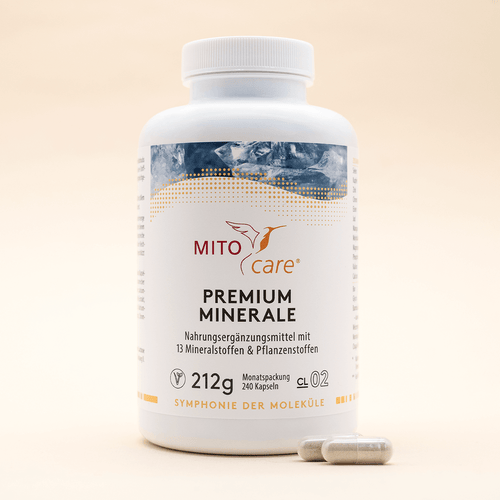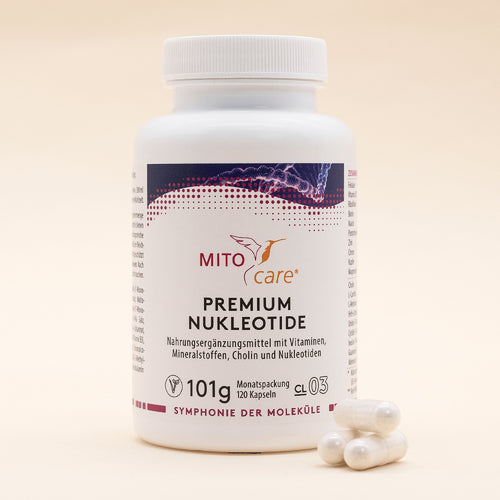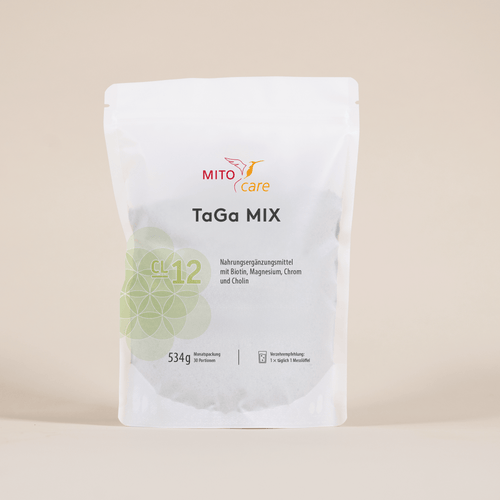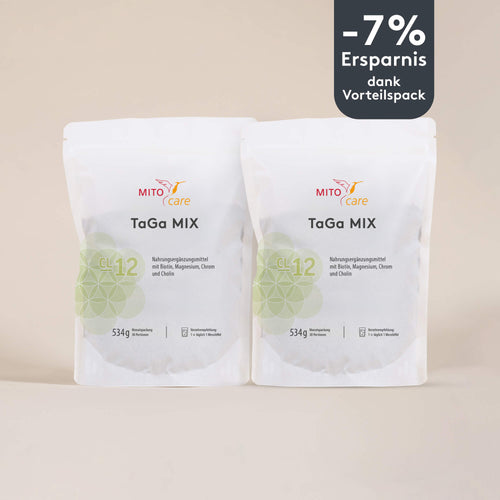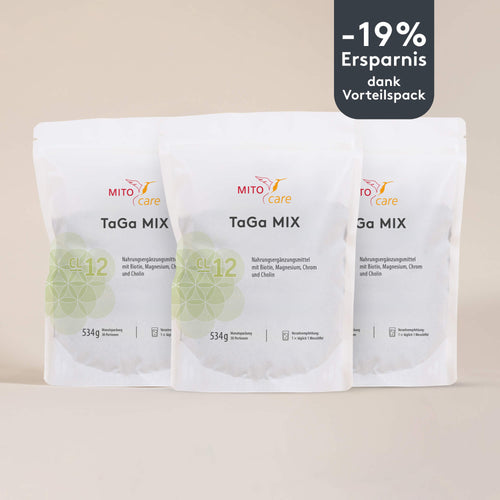Themen dieses Blogartikels:
What is chromium?
Chromium is a mineral that is a trace element. As a chemical element, it has the element symbol Cr and is in the 6th subgroup of the periodic table. Chromium is a so-called transition metal and is found everywhere in nature, for example in water, in the air, in soil and also in food. Trivalent chromium, also known as Cr3+ or Cr (III), is important for the human organism.¹
What are the functions of chromium?
We can absorb chromium not only through the digestive system, but also through the lungs and skin. This trace element is mainly stored in the lungs, liver, spleen and bones.² Its functions in the body are diverse: chromium is important for carbohydrate metabolism, for example, as it is partly responsible for the sufficient release of insulin. It appears to reduce insulin resistance in diabetic patients and normalize fat metabolism and glucose metabolism.³ Your body also needs chromium for thyroid function and protein synthesis.⁴
What makes chromium unique?
In the early 2000s, chromium was still known for its toxicity and was considered to be DNA-damaging and potentially carcinogenic. However, this mainly concerns a special form of chromium, hexavalent chromium, which hardly occurs in nature.⁵ The form that is probably essential for humans, trivalent chromium, fulfills important functions in the body. Once demonized, the picture has changed and chromium is now the focus of research into diabetes and insulin resistance.⁶
How much chromium do you need per day?
The German Nutrition Society (DGE) classifies chromium as an essential trace element that must be supplied to the body from the outside. It specifies the following reference values for daily intake⁷:
| Age | Chromium µg/day |
| Infants | |
| 0 to under 4 months | 1–10 |
| 4 to under 12 months | 20–40 |
| Children | |
| 1 to under 4 years | 20–60 |
| 4 to under 7 years | 20–80 |
| 7 to under 10 years | 20–100 |
| 10 to under 15 years | 20–100 |
| Teenagers and adults | 30–100 |
When do you need chromium most?
In cases of incipient insulin resistance and type 2 diabetes mellitus, chromium supplementation appears to be particularly effective in improving insulin efficiency. In addition, the ability to absorb and utilize chromium can decrease with age, which can lead to an increased need.⁸
How does a chromium deficiency develop and how does it manifest itself?
One possible cause of chromium deficiency is an unfavorable diet. This is because processing methods such as heating, homogenization or refining reduce the chromium content in foods.⁹ So anyone who frequently eats highly processed foods, refined carbohydrates or high amounts of saturated fatty acids risks a nutrient deficiency. In addition, some medications, as well as zinc, can inhibit the absorption of chromium.¹⁰ A lack of chromium can lead to various symptoms such as weight loss, confusion and coordination disorders and increase the risk of diabetes.¹¹
What happens if there is an overdose of chromium?
Chromium poisoning is usually caused by hexavalent chromium, which is used in the metal industry and in leather tanning, for example. Possible health consequences include allergies, asthma and eczema.¹² According to the Federal Institute for Risk Assessment (BfR), the consumption of foods and food supplements enriched with trivalent chromium is safe as long as the total amount of chromium does not exceed 250 µg per day.¹³ Otherwise, even trivalent chromium, which is non-toxic, can cause symptoms of poisoning such as vomiting, diarrhea and even heart failure.14
Which foods are particularly high in chromium?
Shellfish and seafood in particular, as well as Brazil nuts, dried dates and mushrooms contain a lot of chromium. Cocoa powder and black tea also contain a good portion of it.
This dictionary entry is based on carefully researched sources:
Bibliography & Sources
- eufic.org/de/in-our-food/artikel/chrom-in-der-erfutter/
- flexikon.doccheck.com/de/Chrom
- diabetikerbund-sachsen.de/ddb_magazine_rubriken/ratgeber/blutzuckerverwerte-und-der-therapeutische-nutzen-von-chrom/
- flexikon.doccheck.com/de/Chrom
- eurofins.de/umwelt/unternehmen/aktuelles/news/schadstoff-profil-chrom/
- burgerstein-foundation.ch/de-DE/fachbereich/current-from-science-practice/chromium-improves-glycemic-control-in-type-2-diabetics
- dge.de/science/reference values/copper-manganese-chromium-molybdaen/
- vitalstoff-lexikon.de/Spurenelemente/Chrom/Risk groups
- donn-apotheke.de/gesundheitsbibliothek/index/chrom/
- klartext-futterrgaenzung.de/wissen/lebensmittel/futterrgaenzmittel/wechsel-und-nebeneffekt-gegenanzeige-was-futterrgaenzung-verschweigt-50991
- msdmanuals.com/de-de/heim/ern%C3%A4hrungsst%C3%B6rungs/mineralstoffe/chromium deficiency
- infothek-gesundheit.de/chrom-chromlack/
- bfr.bund.de/cm/343/hoechstmengevorschlaege-fuer-chrom-in-lebensmittel-inklusive-smittelergaenzsmitteln.pdf
- vitalstoff-lexikon.de/Spurenelemente/Chrom/Safety Rating




